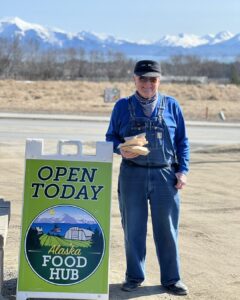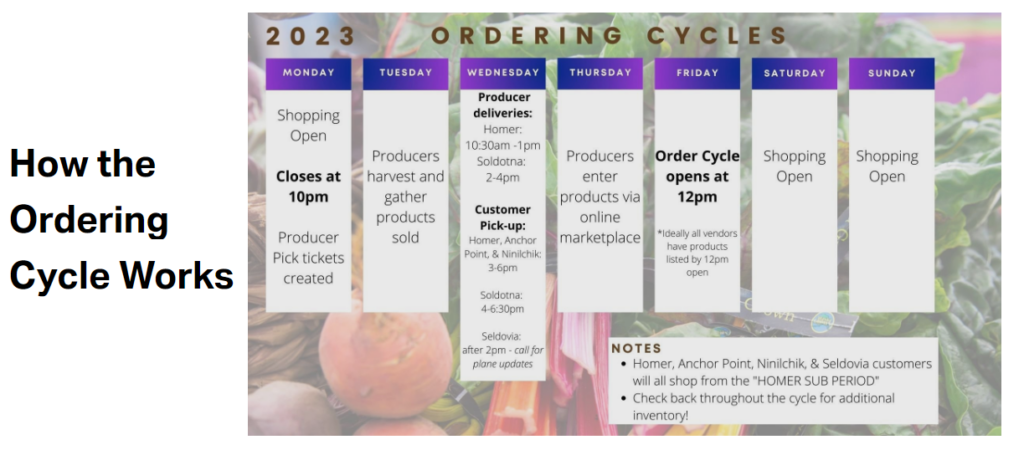Day-to-day guides are helpful for keeping everyone on the same page – this is especially helpful if multiple people are filling the same role, or you rely on volunteers. A policy manual and agreement ensure everyone is on the same page. Here are examples of both:
- Alaska Food Hub – 2021 Policy Manual
- Salt & Soil Marketplace – 2017 Policy Manual
- Alaska Food Hub – 2021 Application and Agreement (Google Form)
- Alaska Food Hub – Vendor Getting Started Guide (2018)
- Alaska Food Hub Day of Operations Guide

This guide from the WALLACE CENTER is designed to help food and farm businesses, food hubs, and USDA GroupGAP administrators develop a basic Quality Management System to identify and meet customer requirements and to create systems for continuous improvement. While the concept of Quality Management Systems (QMS) may be foreign to many, most businesses have asked themselves:
• What do our customers need from us?
• How do we ensure that we can consistently meet those needs?
• How do we train staff?
• How can we become more consistent in our operating practices?
• Who is responsible for what processes?
• How can we do better?
• How do we make sure that if a key staff person leaves the operation can continue to run smoothly?
Policy Considerations Check List:
- Vendor rules
- Communication- describe the method and frequency of communication.
- Products that are allowed/ unallowed
- Can set standard that only local or Alaska made
- No resale of products
- Limit on crafts and arts
- Approval of home produced food
- Permits
- Business license (add business license site),
- Liability insurance-
- Why is this important?
- What type of documentation is needed?
- Describe food hub aggregation locations and hours
- Fees -considerations for vendor fees (description of what the different food hubs in Alaska have done for fees, and other good national models)
- Producers set their own prices.
- Mark up– there will be a percentage markup to cover the costs of operating the food hub. The food hub would take a percentage of the listed price and mark it up by 15-25%, depending on the type of product. The price shown on the online marketplace
- Set and describe your standards for the products. Considerations include:
- Refunds
- Suspension or termination of vendors process
- Labeling of products
- Meet local, state and federal requirements
- Organic (or other scheme) Labeling
- Updating of products during the order cycle
- How to handle complaints
Food Hub Operations: The Basics
Most food hubs have a basic outline of what it takes to participate early on in their food hub manuals. It’s best if this is a relatively short summary with more detail included in later sections. Here is an example from the Alaksa Food Hub, with more specific information discussing each section after:
“How the Food Hub Works: The Basics
- The Alaska Food Hub strives to be a business that is financially viable, environmentally sustainable, and socially just.
- Membership in the Hub is $40 for producers and $1-250 for consumers (sliding scale) annually, regardless if you made any sales during the previous year. Membership fees go toward expenses the Food Hub incurs in the administration, aggregation, and sales of the food. Examples of these expenses are staff time, advertising, and monthly web marketplace fees.
- The Food Hub marks-up products sold 25% (18% for seafood and meats). While grocery stores typically double their cost of products to consumers, Food Hub producers set their own prices based on our 18-25% mark-up. The Alaska Food Hub is a non-profit venture. The markup percentage will be re evaluated annually based on the overall volume of the program and how close we are to breaking even. Our goal is to develop a sustainable pricing strategy that will be fair to producers.
- Volunteer and in-kind labor helps run the Hub and keeps overhead costs low. Please consider volunteering your time to help the cooperative grow and prosper.
- Every member of the food hub is eligible to buy products from, and sell products to, every other member; as long as the producer meets the Food Hub’s Producer Guidelines and has been approved as a vendor.
- Producers are strongly encouraged to disclose the practices used to raise livestock/shellfish, harvest seafood, and grow crops to other members of the Food Hub. In this way consumer members can make informed purchasing decisions about producers and products offered. Full disclosure of growing, farming and production practices forms the basis of trust between the producer and consumer members of the cooperative.
- Producers may only sell products they themselves have grown, processed, harvested or crafted. A producer may not buy wholesale from someone else and then retail the product through the Food Hub.
- Producer members may only sell value-added products that they themselves make. Purchasing ingredients for value-added products is permitted. Value added products must use as many ingredients as possible produced by the member, or purchased from Alaskan farmers. Simply changing the form in which the product is offered for sale, such as repackaging into a smaller size, does not add value and is not permitted.
- Every producer member is responsible to know and follow all appropriate federal, state and local inspections, licenses, statutes and ordinances. Producers must follow all labeling and permitting procedures outlined in the Food Hub policy, and by federal, state, and local policy. The Alaska Food Hub does not take possession of products, but provides a sales platform, customer support, aggregation, and limited transportation.
- Each completed order is a legally enforceable contract to pick up and pay for the products ordered, unless the products are damaged, broken, or undeliverable. Ordering windows will be pre-determined and publicized to all members.
- Producers are responsible for dropping off product and picking up their orders during the times specified. Distribution location and time will be pre determined and publicized to all members.
- Customers are responsible for ensuring they receive all items ordered and for carefully checking their invoices. All product orders must be paid at the time of ordering by credit card; additional purchases, like Food Hub tote bags and membership fees may be paid onsite with credit card. Prompt payment is a condition of membership. “
Other Considerations:
How to access the online marketplace:
- Do you have a vendor log in area and a customer log in area? What is the cost? Is it a yearly membership fee or a flat % rate added to each product or something else?
- For example, Salt & Soil does a sliding scale of various membership fees depending on what you can pay and asking for customers to support more either through donating to a family in need or simply paying for a higher paying membership.
Description of a shopping cycle:
- When does that week officially open and end. Describe when your food hubs order cycle opens and closes: The food hubs of Alaska vary in how long they stay open for sales to customers. Monday-Wednesday is used with Salt & Soil since Southeast Alaskan’s don’t want to either deliver product or pickup product on the weekends and farmers markets are not robust or regular. This is different in the Interior of Alaska where it is more normal to have farmers markets on the weekends so distribution can remain open longer.

Describe when vendors post the products:
- At what day and time can vendors list their products as available for the coming week. For example, often producers can list products the Sunday for the following week, and can add more product as available any day before distribution day. Usually, there is a recommendation to have all products listed for the week by Monday so that the market coordinator can send out a newsletter with all the product updates.
Shopping and Orders:
- This is usually just describing the process of putting an order in your cart, and confirming your order. If there is a way to edit your order then describe how that is done.
Filling of orders:
- Once distribution closes the producers get a “pick ticket” of what was ordered. They prepare as needed to be ready for distribution. This varies greatly depending on what the product type is and how experienced the vendor is. An example of this is a farmer seeing how many bunches of carrots they need to pick, wash, bag, label, and make a plan to drop off for distribution. It’s good practice to have your vendors walk through this process with you verbally or over email so they are clear on what is expected of them.
- During distribution day every hub does it differently but generally speaking, there is a section for refrigerated, frozen, and non-refrigerated items. As customers come up each customer order list is checked off either verbally or with a marker as each item is delivered to them so that there are no discrepancies or misunderstandings.
Aggregation of orders:
- Be clear about the time, location and condition/packaging of food for drop off. Usually, there is a drop-off window of several hours or whatever works for that distribution site. Sometimes food hub coordinators go around and pick up large orders of products if they are on the way to the site. But most often the distribution site will have drop-off hours before customer pickup hours. For example, Salt & Soil has 3 hours of drop off before they do 3 hours of customer pickup hours on Thursdays.
Vendor drop-off locations
- Sometimes vendors work together to drop off items if driving long distances from a farming area to a more urban location.
- Or they might make arrangements to drop off a day early if it works better with their schedule.
- Some food hubs offer delivery to the hub or distribution sites.
- Every hub needs to figure out the optimal way to make it as easy as possible for vendors to drop off as it is one of the major barriers to participation.
Customer pick-up locations.
- You can have multiple pickup locations if it works for your distribution system, and each can have slightly different pickup times. Either way, it is important to clearly state pick-up times and what will happen if orders are not picked up during the specified time.
- For example, customers are expected to show up at their pickup location from 3 to 6 pm. Orders can also be selected for delivery for a fee of X dollars. Orders not picked up will be held if not perishable for one day. Orders not picked up during distribution hours will not be refunded barring legitimate reason. Please speak to the distribution manager as soon as possible to arrange an alternative pickup if you cannot make it. All perishable orders will be donated to a local food bank, charity, or shelter.